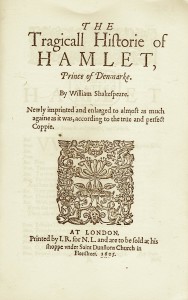 When I studied textual criticism and palaeography at University under the legendary Peter Davison (editor of Orwell’s letters) I recall being impressed by the exceeding rarity of the original quarto editions of Shakespeare’s plays. Rarer than hen’s teeth was, I believe, the phrase used. This was because the actors who used them to learn their lines in Shakespeare’s time had no reason to keep them after their acting careers had ended. Shakespeare was just another playwright, and it was only with the posthumous publication of the First Folio in 1623, when all the plays were collected together, that his true greatness began to be recognised.
When I studied textual criticism and palaeography at University under the legendary Peter Davison (editor of Orwell’s letters) I recall being impressed by the exceeding rarity of the original quarto editions of Shakespeare’s plays. Rarer than hen’s teeth was, I believe, the phrase used. This was because the actors who used them to learn their lines in Shakespeare’s time had no reason to keep them after their acting careers had ended. Shakespeare was just another playwright, and it was only with the posthumous publication of the First Folio in 1623, when all the plays were collected together, that his true greatness began to be recognised.
These pamphlet-like quartos—often badly printed and containing countless errors—were published in small numbers and were not surprisingly badly treated by the jobbing actors who used them every day. Very few survived, hence their great rarity. Despite this, it wasn’t until the early twentieth century, when American multi-millionaires came into the market, that the first quartos began to fetch startling prices—startling, that is, for the time. Today, such treasures might bring in six figure sums.
One sale in which these early quartos featured, alongside examples of the very earliest English drama, was held at Sotheby’s in May 1906. From the Hussey library the following quartos made : Merchant of Venice (1600) £460; King Lear ( 2nd ed 1608) £395; Merry Wives of Windsor (2nd ed. 1619) £295; A Midsummer Night’s Dream (1600) £280 ; Pericles (3rd ed. 1619) £161; Henry V. ( 3rd ed. 1608) £150; Lancaster and York ( 1619) £110. At another sale on March 30th: Titus Andronicus (2nd ed. 1611) £106. Some of the quartos achieved record prices.
To put these prices into perspective one should note that the bulkiest quarto (‘Lancaster and York’) was comprised of just 64 leaves while ‘Henry V’ had 28 leaves. Compare these flimsy items with a copy of the First Folio, which sold on June 1st 1906 for just £280, and it becomes obvious that the scarcity of these quartos together with the thrilling notion that some of them may have been handled by Shakespeare’s troupe of actors, or even by the Bard himself, are factors that will have boosted their values.
Some of the equally rare examples in quarto of early English drama, such as Gammer Girton’s Nedle (1575 ) and Thomas Nash’s ‘Summer’s Last Will and Testament’ (1600), also achieved record prices, but only a fraction of what the quartos fetched. It should also be noted that a presentation copy of William Blake’s exceedingly rare debut collection, Poetical Sketches (1783) made just £109 at a time when Blake was just beginning to be appreciated.
Such was the power of the Bard! Today, that power has remained undiminished. In 2017, while copies of some early English drama might struggle to replicate (in real terms) the prices of 1906, the news that just one first quarto of a great Shakespeare play was about to be sold at auction, would generate enormous interest throughout the world. So few of these treasures have survived that the interest would surely greatly exceed that generated by the discovery a few years ago of that imperfect First Folio in a French library. As for the price that such an astonishing rarity would fetch—one can only guess. I’m guessing a low seven figure sum. [RR]
